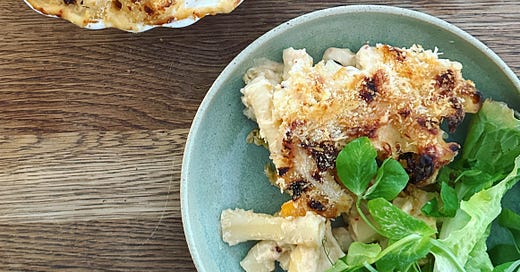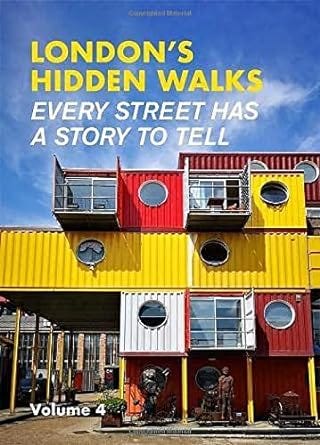In Good Taste #17: MacCauliflower KimCheese
A composite of two comfort food classics, made even better with kimchi; a brief guide to the lifecycle of of Korea's favourite ferment; walking ruined Wren churches and re-reading Ursula Le Guin
Well, hello there! How are you?
Good I hope. Thank you so much for being here.
(Not up for the chitchat? Completely get it. Click the email title to go to a web-based version then jump straight to the recipe or Cultural Fun.)
Well, autumn escalated quickly. It’s not long ago that I was looking out ice packs to put under my pillow during the surprise heatwave and now here I am, knee-deep in rustling leaves and contemplating getting the big duvet out.
Autumn is one of my favourite times of year for food. There’s still plenty of late summer produce but you can start thinking about heartier ways to cook it. Roast veg salads, sustaining stews and, of course pasta dishes.
Today’s recipe is a variation on one of my most popular ready meals. What I call MacCauliflower Cheese. It is, as the name suggests, a combination of Mac & Cheese and Cauliflower Cheese. I usually add leeks and peas for a bit of extra veg but today, since we’re livening the whole dish up with kimchi, I think there’s enough going on already and am going to leave them out. But feel free to chuck in whatever additions you fancy. See the recipe notes for a few ideas.
The circle of life (kimchi version)
Whether homemade or shop bought, all kimchis go through a similar lifecycle. When first made, before fermentation has begun, the flavours are bold and brash. If eaten at this stage, as a spicy salad, it is called geotjeori. Over the first few weeks of fermentation, the flavours mellow and meld and things get tangy and a little funky. This is when it’s usually eaten as an accompaniment or side dish.
As it continues maturing, the kimchi gets more and more acidic. Kimchi that has aged for six months or more is known as mugeunji and generally used for cooking. Older kimchi is great for making fried rice or a spicy kimchi jiggae stew.
You can make this pasta recipe with kimchi at any stage but I think I prefer it with stuff that’s not quite so old. I used the jar I made a couple of weeks ago and it worked really well, tangy in a way that matched the cheddar but not overpoweringly acidic. Whatever you use remember to taste the sauce and adjust seasoning accordingly.
Recipe: MacCauliflower KimCheese
Serves 4 as a main or 6 as a side
Ingredients
200g dried pasta of your choice
1 small cauliflower cut into florets (approximately 300g)
1 tsp neutral cooking oil
50g butter
60g flour
600ml whole milk
150g strong Cheddar cheese, grated
200g kimchi
salt
30g Parmesan (or vegetarian hard cheese), grated
20g breadcrumbs (I use panko)
Method
Set your oven to 180°C.
Cook the pasta in plenty of boiling, salted water. Give it two minutes less than the packet suggests. You want it very al dente as it will soften a little more in the sauce as the dish bakes.
Boil the cauliflower for 3 minutes. I hate washing up so like to do this in the same pan as the pasta, adding it three minutes before the end of my calculated cooking time. But if your pan is small or you can’t be bothered with the maths, do it separately.
Drain the pasta, pour on a tsp or so of oil and toss it through so the pieces don’t clump and stick together.
Put the pan back on a medium-high heat and add the butter and flour. Stir to combine well (the mixture will look like wet sand) and cook, stirring, for a couple of minutes. It should begin to brown slightly and smell biscuity. A little colour is great for flavour but don’t let the flour get too dark or it will lose its thickening ability.
Take the pan off the heat and add the milk in generous splashes. About 50ml at a time to start with. The roux (your cooked flour and butter mixture) will absorb it and seize up. Use a whisk to get everything smooth again before adding the next splash. Once the mixture is looser you can add the rest of the milk in one go. It should be roughly the consistency of single cream.
Put the pan back over a medium heat and stir as it comes to the boil and thickens. Continue cooking and stirring as it bubbles for about two more minutes. It should now be a double cream consistency.
Remove from the heat, add the cheese and stir it in. There should be enough heat to melt it into the sauce. Add the kimchi as well. Taste and season. The kimchi is quite salty so you shouldn’t need much more but a pinch will make the flavours pop. (Obviously, if you’re in a hurry, you could make your sauce whilst the pasta is cooking. I don’t because of the washing up antipathy mentioned earlier.)
Add the pasta and cauliflower to the sauce and fold it through so everything is evenly coated.
Transfer to an oven dish. Sprinkle over the Parmesan and finish with the breadcrumbs.
Bake for 20 mins or until the top is golden brown and crunchy and the sauce is bubbling.
Notes (If Ifs And Ands Were Pots And Pans…)
As I said above, my standard MacCauliflower Cheese contains both leeks and peas. I haven’t added them here but throw in whatever you fancy. Peas are nice for the sweetness they bring or I have a hunch that edamame beans would be good, adding nutty little punctuation marks to the dish.
Crispy bacon would be great too or leftover roast chicken.
Again, my standard dish has both mustard and nutmeg in the sauce. I don’t think they’re needed here but taste and season according to your kimchi.
Use any shape of pasta you have to hand. I actually prefer bigger tubes to macaroni as there’s more room for the sauce to get inside.
You can obviously make this with just the pasta or just the cauliflower. Double the quantity of your favoured ingredient or halve the sauce.
You can make this up to stage 10 ahead of time and cook from chilled (around 30 mins) or frozen (about 50). Keep an eye on it to make sure the top doesn’t burn - cover with foil if it’s getting too brown before the middle is up to temperature.
Cultural Fun
I can’t remember if I’ve mentioned them before but James and I are big fans of the London’s Hidden Walks series by Stephen Millar. The maps aren’t great but it’s incredible how many things are hiding in plain sight, even in areas you thought you knew well.
We only recently got Volume 4 which came out last year and did the Lost City Walk at the weekend, full of ruined Christopher Wren churches in and around the Square Mile. In my pre-chef days I worked on Lower Thames St and often used to take my packed lunch (or Pret sandwiches) to St Dunstan In The East, the remains of a Wren church that was damaged in the Blitz and is now a public garden. Due to last week’s phone-stealing, I didn’t have a decent camera at the time but you get the vibe from this Instagram post.
There were so many others nearby though! Places I must have walked within metres of hundreds of times and never known about. Plus a non-ruined Wren church, St Stephen Walbrook, which was also new to me. It’s a lovely mixture of classic and modern, the 17th century architecture set off by a circular central altar by Henry Moore surrounded by colourful Patrick Heron kneelers. There’s an art installation on there until Sunday with a lighted pendulum swinging above the altar, part of a series of events marking the 300th anniversary of Wren’s death. It was pleasant to stop for a moment and watch the pendulum rotate. Perhaps not a must-see thing to travel for, but worth popping in on if you’re nearby.
I’ve been rereading Ursula Le Guin’s Earthsea books. I was inspired to revisit them after listening to an episode of The Last Archive podcast in which host Ben Naddaff-Hafrey told the story of Ishi a Native American man, the only member of his community to survive a genocide, taken to live in the Anthropology department at the University of California, Berkeley.
Le Guin’s parents were among those studying Ishi - the case made them famous - and his treatment was partial inspiration for her short story The Ones Who Walk Away from Omelas in which the happiness of an entire city is dependant on the misery of a single child.
I still haven’t read …Omelas but I loved the Earthsea books as a child and Naddaff-Hafrey’s enthusiasm for them made me want to go back. The idea of a school for wizards was captivating. Le Guin wrote about Roke 30 years before JK Rowling brought us Hogwarts. And it was darker and stranger, her idea of what magic is and its place in the world more fully realised.
The second book was always my favourite. In the Tombs of Atuan our wizard (anti)hero Ged is trapped in an underground labyrinth at the mercy of a child priestess. Re-reading it, the sense of claustrophobic darkness was just as vivid as I remembered. But although I’d responded to the slight melancholy and palpable threat of Earthsea the first time round, it’s only in revisiting the books as a grown-up that I realise how brave they were in refusing to deliver traditional happy endings, always leaving things with a sense of delicate imbalance.
I never read much more of her stuff in my youth but, on a recommendation from my mother, am moving on to The Left Hand of Darkness next. Are you a fan? Anything else I should put on my list?
Bye! See you soon!
In the meantime, if you felt like sharing In Good Taste with friends or family who might enjoy it, you can do so with the button below. It would mean the world to me. Thanks so much.
In Good Taste is a Sycamore Smyth newsletter by me, Clare Heal.
You can also find me on Instagram or visit my website to find information about my catering work, cookery lessons and upcoming events.







